
The coat of arms of Germany displays a black eagle with a red beak, a red tongue and red feet on a golden field, which is blazoned: Or, an eagle displayed sable beaked langued and membered gules. This is the Bundesadler, formerly known as Reichsadler. It is one of the oldest coats of arms in the world, and today the oldest national symbol used in Europe.

Immigration to Germany, both in the country's modern borders and the many political entities that preceded it, has occurred throughout the country's history. Today, Germany is one of the most popular destinations for immigrants in the world, with well over 1 million people moving there each year since 2013. As of 2019, around 13.7 million people living in Germany, or about 17% of the population, are first-generation immigrants.
A controlled substance is generally a drug or chemical whose manufacture, possession and use is regulated by a government, such as illicitly used drugs or prescription medications that are designated by law. Some treaties, notably the Single Convention on Narcotic Drugs, the Convention on Psychotropic Substances, and the United Nations Convention Against Illicit Traffic in Narcotic Drugs and Psychotropic Substances, provide internationally agreed-upon "schedules" of controlled substances, which have been incorporated into national laws; however, national laws usually significantly expand on these international conventions.
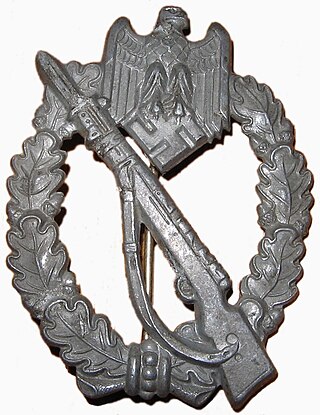
The Infantry Assault Badge was a German military decoration awarded to Waffen-SS and Wehrmacht Heer soldiers during the Second World War. This decoration was instituted on 20 December 1939 by the Commander-in-Chief (Oberbefehlshaber) of the German Army, Generalfeldmarschall Walther von Brauchitsch. It could be awarded to members of infantry and Gebirgsjäger units that had participated in infantry assaults, with light infantry weapons, on at least three separate days of battle in the front line on or after 1 January 1940. When a counter-offensive led to fighting, it could also apply. Award of the Infantry Assault Badge was authorized at regimental command level, and mechanized or motorized infantry were not eligible for the original badge. A bronze variant of the Infantry Assault Badge was created in June 1940, authorized for motorized and mechanized infantry units, using similar requirements for award as the original silver variant. Non-infantry personnel were not eligible for either grade of the Infantry Assault Badge, but were eligible for other combat recognition badges, usually the General Assault Badge, Close Combat Clasp, or the Panzer Badge. The Luftwaffe would develop its own ground combat badge in 1942, the Ground Assault Badge.
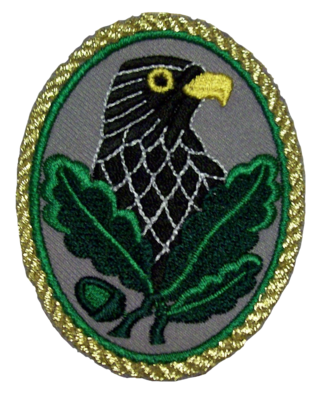
The Sniper's Badge was a World War II German military decoration awarded to snipers. It was instituted on 20 August 1944. Initially, only personnel serving in the German Army and the Waffen-SS were eligible. Later, by order of the High Command, it was also made available to snipers of the other armed services.
The Danzig Cross was a Nazi decoration of the Free City of Danzig. The Cross was instituted on 31 August 1939 as a two grade decoration by Danzig Gauleiter Albert Forster. It was awarded to those, both in Danzig and in the wider Reich, who contributed to building up the Nazi Party in the Free City prior to its incorporation into Germany on 1 September 1939.

The German laws regulating alcohol use and sale are mostly focused on youth protection. In contrast to many other countries, legislation is relatively lenient and not designed to keep young people away from alcohol, but rather intended to teach them an appropriate approach to alcohol consumption, which is reflected by one of the lowest drinking ages in the world.
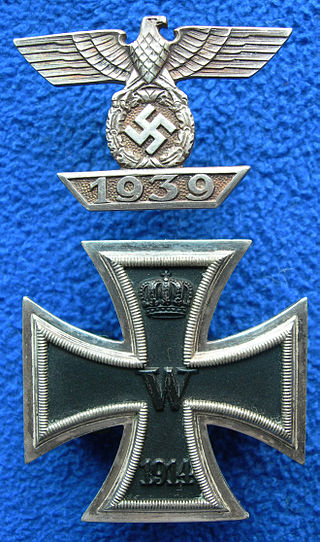
The Clasp to the Iron Cross was a white metal medal clasp displayed on the uniforms of German Wehrmacht personnel who had been awarded the Iron Cross in World War I, and who again qualified for the decoration in World War II.

Hans-Joachim von Merkatz was a German politician. He was Federal Minister of Justice from 1956 to 1957. He was a member of the Bundestag from 1949 to 1961. He was a member of the German Party before joining the Christian Democrats in 1960.

2-Fluoromethamphetamine (2-FMA) is a stimulant drug of the amphetamine family which has been used as a designer drug. 2-FMA is commonly compared to lisdexamfetamine (Vyvanse), and dextroamphetamine due to its efficacy as a study or productivity aid. 2-FMA is purported to produce somewhat less euphoria than comparable amphetamines, likely due to its main mechanism of action consisting of norepinephrine reuptake inhibition.

The Awards and decorations of the German Armed Forces are decorations awarded by the German Bundeswehr, the German government, and other organizations to the German military and allied forces. Modern era German military awards have been presented since the establishment of the Federal Republic of Germany in 1949.

A Naturschutzgebiet is a category of protected area within Germany's Federal Nature Conservation Act . Although often translated as 'Nature Reserve' in English, the Federal Agency for Nature Conservation (BfN) refers to them as 'Nature Conservation Areas'. It meets the criteria of an IUCN Category IV Habitat and Species Management Area.
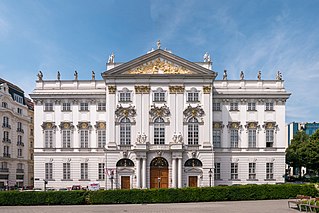
The Ministry of Justice is the government ministry of Austria responsible for the administration of justice. The ministry exercises administrative supervision and is charged with the compensation of the judiciary and the prosecutors, manages their office buildings and facilities, and administers the prison system.
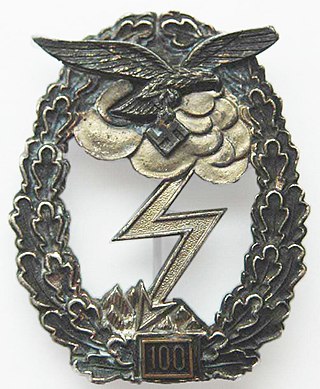
The Ground Assault Badge of the Luftwaffe was a World War II German military decoration awarded to Luftwaffe personnel for achievement in ground combat. It was instituted on 31 March 1942 by the commander-in-chief Hermann Göring.

The Federal Office for Economic Affairs and Export Control is a German federal agency. The BAFA is authorised to make the final decision on whether German goods are permitted for export.
Drugs controlled by the German Betäubungsmittelgesetz (BtMG). Trade and possession of these substances without licence or prescription is considered illegal; prescription is illegal for drugs on Anlage I and II and drugs on Anlage III require a special prescription form.

The Protection of Young Persons Act is a federal law in Germany to enforce youth protection in public spaces and regulate media consumption by minors. The act does not apply to minors who are married.
The Decoration of the Federal Agency for Technical Relief is a German decoration founded in 1975. It is awarded by the Technisches Hilfswerk (THW) and is approved by the President of Germany.

The Courland Cuff Title, or Courland Cuff Band, was a World War II German military decoration awarded to Wehrmacht servicemen of Army Group Courland who served in the Courland Pocket.

Inner German relations, also known as the FRG-GDR relations, East Germany-West Germanyrelations or German-German relations, were the political, diplomatic, economic, cultural and personal contacts between the two countries; Federal Republic of Germany and German Democratic Republic, at the period of the official West-East division in German history from the founding of East Germany on 7 October 1949 to Germany's reunification on 3 October 1990.
















